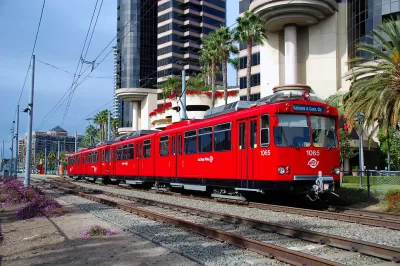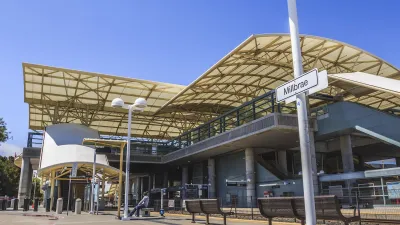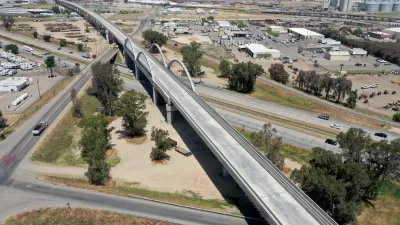Experts attribute the high cost of the project to local opposition and call on state and federal leaders to give transportation agencies more authority over local jurisdictions.

A report from UC Berkeley found that San Diego's Blue Line trolley extension cost double the per-mile average for similar projects, but was completed in half the average time. Joshua Emerson Smith outlines the findings of the study, which also analyzed four other rail projects in the state.
Ethan Elkind, co-author of the report, says the high cost of the San Diego project is indicative of the many challenges faced by rail initiatives in places like California. According to Elkind, the project was "well executed," but remains a "cautionary tale." The San Diego Association of Governments (SANDAG) worked with local stakeholders to reduce opposition and mitigate community concerns, raising the cost of the project by promising new parking spaces in certain areas and elevating the trolley tracks on the UC San Diego campus.
The report recommends that state and federal leaders "crack down" on local opposition to rail projects, with Elkind arguing that "we need to empower transit leaders to make decisions for the good of the region and not always give in to local demands along the route." But agency leaders like SANDAG Executive Director Hasan Ikhrata are reluctant to take an aggressive approach or take away local land use authority.
Other California rail projects have shown varied results: while San Francisco's Central Subway project has encountered major delays and cost increases, L.A.'s Purple Line extension is costing 70 percent of the national average. The report calls the state's beleaguered high-speed rail project "a case study in how not to build rail," citing the project's lack of foresight in securing land acquisition before designing routes.
FULL STORY: San Diego’s Blue Line trolley extension cost twice U.S. average for light rail, study finds

Trump Administration Could Effectively End Housing Voucher Program
Federal officials are eyeing major cuts to the Section 8 program that helps millions of low-income households pay rent.

Planetizen Federal Action Tracker
A weekly monitor of how Trump’s orders and actions are impacting planners and planning in America.

Ken Jennings Launches Transit Web Series
The Jeopardy champ wants you to ride public transit.

‘Minnesota Nice’ Isn’t so Nice When You Can’t Find a Place to Live
The Economic Development and Housing Challenge Program can help address the scourge of homelessness among Indigenous people.

NYC Open Streets Organizers Call for City Support
The number of open streets projects has dropped year after year as volunteer groups struggle to fund and staff them.

Crime Continues to Drop on Philly, San Francisco Transit Systems
SEPTA and BART both saw significant declines in violent crime in the first quarter of 2025.
Urban Design for Planners 1: Software Tools
This six-course series explores essential urban design concepts using open source software and equips planners with the tools they need to participate fully in the urban design process.
Planning for Universal Design
Learn the tools for implementing Universal Design in planning regulations.
Heyer Gruel & Associates PA
Ada County Highway District
Institute for Housing and Urban Development Studies (IHS)
City of Grandview
Harvard GSD Executive Education
Toledo-Lucas County Plan Commissions
Salt Lake City
NYU Wagner Graduate School of Public Service





























